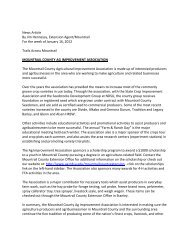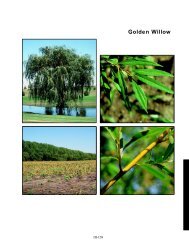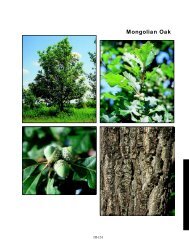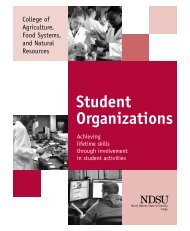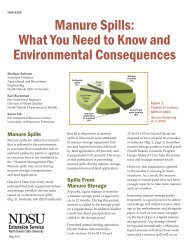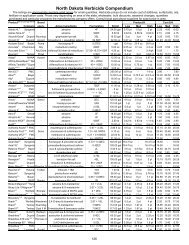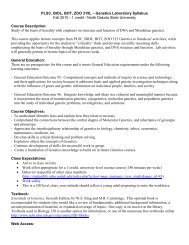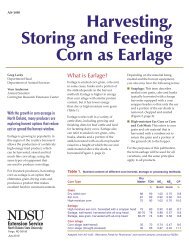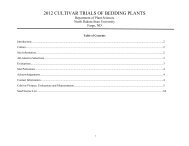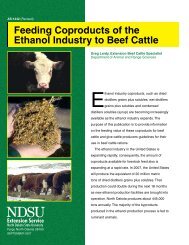NDSU Beef Feedlot - NDSU Agriculture - North Dakota State ...
NDSU Beef Feedlot - NDSU Agriculture - North Dakota State ...
NDSU Beef Feedlot - NDSU Agriculture - North Dakota State ...
Create successful ePaper yourself
Turn your PDF publications into a flip-book with our unique Google optimized e-Paper software.
Effect of Glycerol Level in <strong>Feedlot</strong> Diets on Animal Performance and<br />
Carcass Traits<br />
B.R. Ilse 1 , V.L. Anderson 1 , T.M. Jeske², R.J. Maddock 2 , and E.P. Berg 2<br />
1 <strong>NDSU</strong> Carrington Research Extension Center<br />
2 <strong>NDSU</strong> Department of Animal Sciences<br />
Abstract<br />
Two separate feedlot trials were conducted (receiving and finishing) to evaluate the effects of<br />
increasing levels of glycerol on animal performance. Receiving trial steers (n = 198) were allotted by<br />
BW (622.6 ± 34.32 lbs.) in a randomized complete block design and sorted into 16 identical pens (four<br />
pens per treatment). Treatments were 0, 6, 12, and 18 percent glycerol (70% DM; water was added to<br />
reach 70% DM to increase the viscosity and decrease freezing temperature) on a DM basis replacing<br />
dry-rolled corn and co-products in the diet (55 Mcal/lb NEg). Dry matter intake was quadratically<br />
affected during the 30-d feeding period (P = 0.05) with 20.38; 21.07; 21.13; 19.47 pounds consumed for<br />
0, 6, 12, and 18 percent glycerol, respectively. Gains were not affected by glycerol level (P = 0.79) and<br />
feed efficiency was similar (P > 0.92) among treatments. Finishing trial heifers (n = 132; BW = 911.5 ±<br />
33.22 lbs.) were blocked by weight and allotted to one of 16 pens, assigned to 0, 6, 12, 18 percent<br />
glycerol (85% DM) dietary treatments (60 Mcal/lb NEg). Dry matter intake linearly decreased during the<br />
102-d feeding period with increasing glycerol level (P = 0.05; 28.11; 27.97; 27.71; 26.16 lbs. for 0, 6,<br />
12, and 18% glycerol, respectively). Gains were not affected by glycerol level (P = 0.26) during any of<br />
the four individual 28-d weigh periods or overall. Feed efficiency was also similar (P > 0.22) among<br />
treatments. If the availability of feed-grade glycerol increases with the increase in biodiesel production,<br />
glycerol could be a viable alternative to corn in feedlot diets.<br />
Key words: glycerol, beef, feedlot<br />
Introduction<br />
The glycerol (or glycerine) supply may increase dramatically throughout the <strong>North</strong>ern Plains states and<br />
Canadian provinces with the development of the biodiesel industry. Glycerol is a three-carbon alcohol<br />
produced by transesterification of vegetable oil (e.g. soybean) or animal fat. Approximately 10 percent<br />
of the original weight of the vegetable oil is converted to glycerol in the process to produce biodiesel.<br />
This glycerol or glycerine product is primarily utilized in industrial products such as cosmetics, liquid<br />
soap, antifreeze, and lubricants. If glycerol can be used successfully as a feed, beef cattle are the<br />
largest potential year-around market outlet in <strong>North</strong> <strong>Dakota</strong>. A few research trials with dairy cattle<br />
support the use of glycerol as an energy source for ruminants, but no production feedlot research has<br />
been reported in the <strong>North</strong>ern Plains (DeFrain et al., 2004; Linke et al., 2004; Bodarski et al., 2005).<br />
Glycerol is currently used in some formulations of liquid feed products. The energy value of glycerol is<br />
about equal to corn on a pound for pound basis and therefore could be of great value for a livestock<br />
feed based on competitive pricing and availability. This trial was designed to study the effects of<br />
glycerol included as an energy source in receiving and finishing rations on animal performance.<br />
Page 24 2009 <strong>NDSU</strong> <strong>Beef</strong> <strong>Feedlot</strong> Research Report




